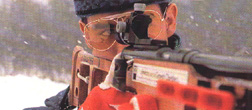| |
Essential motivation of Sports Vision
Through decades of research on the physiology and psychology of visual perception, some of the concepts appear to be universally demonstrated and accepted:
- The visual function is largely a learned process that can be adequatly educated, trained and improved.
- The great plasticity of the visual system and of the functions that it carries out is largely due to sensory learning
phenomena and refer to the enormous and partly unused plasticity of the cerebral processes.

- The human visual system is the most developped and efficient among all living creatures.
More than two thirds of sensory information arriving every second to the brain is relative to the visual function.
"Seeing" has already been defined as the dominant functions in the human being. The use that the human being
must make of it, greatly overtakes that of the primary survival necessities and contributes to the superior aspects of
existance, those more exquisitely cognitive and cultural.
- Sports, such as the majority of activities that we perform each day, is, essentially a visuo-motory activity.
Each sporting action is charactirized by a perception followed by an action mediated by an infinity of integrative
processes contributing to make the final gesture adequate to the spatial and temporal situations. No other sensory
system is as precise, fast and refined as the visual function in "measuring" time and space.

- Systematic repetition of movements does not necessarily produce adequate learning.
The motory gesture is the final product springing from series of phenomena: a sort of outcome of efficiency and
integration. Each action-reaction is mediated by sensory processes. If these are not adequatly integrated, a training
that is based only upon repetition of movements or upon physical strenth could result significantly ineffective in the
purpose of improving the subject's performance.
Training the visual function to be more prepared, faster and more accurate can yield a considerable contribution in
the improvement of motion, both in terms of quantity (velocity) and quality (precision).
|
|